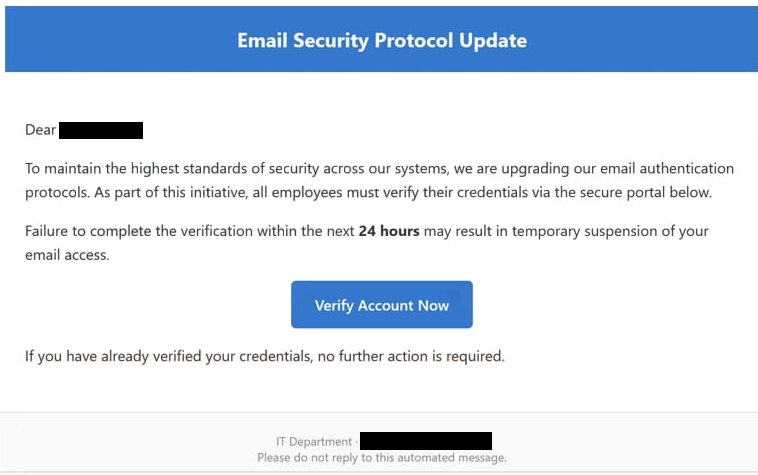Remove “Email Security Protocol Update” email
The “Email Security Protocol Update” email is a phishing attempt, disguised as a notification from a company’s IT department. According to the email, the company users work at is upgrading their email authentication protocols to maintain the highest standards of security. Supposedly, all employees have to verify their credentials within 24 hours. Failure to do so will result in the suspension of the email. The email includes a link leading to a phishing site that asks users to type in their email login credentials. If users do as asked, the credentials will be stolen by the malicious actors operating this phishing campaign.
This “Email Security Protocol Update” email may be targeting employees of specific companies in order to gain access to important email accounts. It may also be targeting random users, hoping they work in a company with an IT department that would send such an email. Whatever the case may be, falling for this phishing attempt will result in lost access to the email account.
Entering your login details on a phishing site linked in this email would give cybercriminals access to your email account. Email credentials are especially valuable because email accounts hold a lot of personal and sensitive information and are often connected to other accounts. If hackers gain access to your email, they might be able to access those linked accounts too. Even if the hackers don’t use the stolen credentials themselves, they can sell them to others. Overall, falling for a phishing attempt of this type will likely have serious consequences.
The full “Email Security Protocol Update” email is below:
Subject: Email Security Protocol Update {please confirm}
Email Security Protocol Update
Dear -,
To maintain the highest standards of security across our systems, we are upgrading our email authentication protocols. As part of this initiative, all employees must verify their credentials via the secure portal below.
Failure to complete the verification within the next 24 hours may result in temporary suspension of your email access.
Verify Account Now
If you have already verified your credentials, no further action is required.
IT Department · -.com
Please do not reply to this automated message.
How to recognize phishing emails
The opening line of the “Email Security Protocol Update” email is a clear indicator of a phishing attempt, as you are addressed by your email username. Addressing you with your email username rather than your name is a significant red flag, especially from an email supposedly sent by your place of employment. Legitimate emails will always address you by name. Generic phishing attempts often come from attackers with limited access to personal information, which is why they rely on generic greetings or usernames. If the sender should know your name but fails to use it, the email could be a phishing attempt.
When receiving unsolicited emails with attachments or links, always verify the sender’s email address before taking any action. Many low-effort phishing emails are sent from fake or suspicious email addresses. More sophisticated phishing attempts may use addresses that appear legitimate, but doing a quick online search can help confirm their authenticity. If no information is available about the sender’s address, it is likely a phishing attempt.
Another common sign of phishing is poor grammar or spelling mistakes in the email. Phishing emails often contain grammar and spelling mistakes, awkward sentence structure, unusual formatting, etc. In contrast, legitimate emails, especially those related to account security, are typically professional and well-written. This “Email Security Protocol Update” email is fairly professional-looking and is more sophisticated than many other phishing attempts.
Even if a phishing email appears polished, examining the links can expose the scam. Hovering over the links will show their destination, and if anything seems suspicious, avoid clicking. Keep in mind that scammers frequently disguise links by rearranging or altering letters to make them look authentic.
To prevent accidentally entering your login credentials on a phishing site, avoid clicking links in emails altogether. Instead, access your accounts directly through a web browser, particularly if the email claims there is an issue with your account. Keep in mind that phishing websites may closely mimic legitimate ones, so extra caution is necessary.
Remove “Email Security Protocol Update” email
You can safely delete “Email Security Protocol Update” email, as it is a phishing attempt. If you’ve clicked on any links within the email and typed in your login credentials on a suspicious website, change your password right away. Should you suspect your account is compromised and you’re unable to access it, use all available recovery options. If you’re still having trouble regaining access, make sure to disconnect your email from any associated accounts.
Site Disclaimer
WiperSoft.com is not sponsored, affiliated, linked to or owned by malware developers or distributors that are referred to in this article. The article does NOT endorse or promote malicious programs. The intention behind it is to present useful information that will help users to detect and eliminate malware from their computer by using WiperSoft and/or the manual removal guide.
The article should only be used for educational purposes. If you follow the instructions provided in the article, you agree to be bound by this disclaimer. We do not guarantee that the article will aid you in completely removing the malware from your PC. Malicious programs are constantly developing, which is why it is not always easy or possible to clean the computer by using only the manual removal guide.

